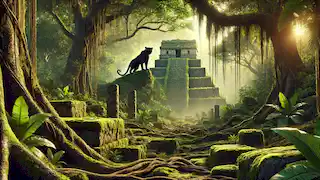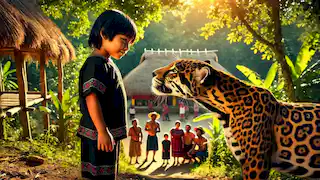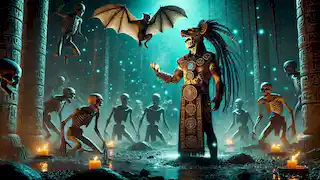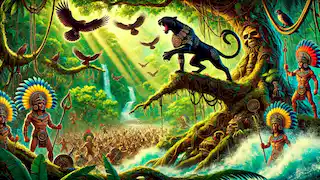The Legend of the Black Jaguar
Reading time: 7 min

About this story: The Legend of the Black Jaguar is a Legend from Mexico set in the Ancient This Dramatic tale explores themes of Courage and is suitable for All Ages. It offers Cultural insights. A Mayan legend of courage, sacrifice, and the mystical bond between man and the divine.
Deep in the lush and untamed heart of the Yucatán jungle, where the trees whisper secrets to the wind and the rivers carve ancient paths through the earth, there is a tale older than time itself. It is a tale of power, loyalty, and transformation. The legend of the Black Jaguar is not just a story—it is a bridge to the soul of the Maya, a culture that revered nature, life, and the mysteries of the cosmos.
Long ago, before the stone temples of the Maya reached to the heavens and before the stars were etched into the codices, the people lived in harmony with the jungle. They worshipped the gods who gave them rain, sun, and maize. Among their many deities was Balam, the jaguar god who guarded the balance of life and death. The people believed Balam could walk between worlds—both the realm of the living and the shadows of Xibalba, the underworld. His physical manifestation, the Black Jaguar, was both feared and revered, said to possess the wisdom of the gods and the ferocity of the wild.
The Chosen One
The village of K’an Tunich, a small settlement deep in the jungle, was known for its skilled artisans and wise shamans. One fateful night, as the full moon bathed the jungle in silver light, a child was born under a rare celestial alignment. His name was Itzamná, meaning "lizard house," named after the god of wisdom and creation. The shaman of the village declared his birth an omen, for the stars foretold he would have a destiny entwined with the gods.
From a young age, Itzamná displayed unusual traits. He spoke to the animals of the jungle and seemed to understand their responses. He could sense storms long before they arrived and often wandered into the wilderness, only to return unscathed. The villagers whispered that he had Balam’s spirit within him.
One day, when Itzamná was only twelve, a mysterious black jaguar appeared at the edge of the village. It locked eyes with the boy, its golden gaze filled with intelligence and power. Without fear, Itzamná approached the jaguar, and to everyone’s astonishment, the beast bowed its head before him. The shaman declared this a sign from Balam himself: Itzamná was chosen for a great purpose.

The Trial of Shadows
As Itzamná grew, the village prepared him for his destiny. The shaman revealed that the Black Jaguar was more than an earthly creature—it was a guardian of balance and a protector of the sacred jungle. The gods had chosen Itzamná to take on this role, but first, he had to undergo the Trial of Shadows, a journey to the underworld, Xibalba.
On the night of his seventeenth year, under a moonless sky, Itzamná entered the Cenote of Shadows, a sacred sinkhole believed to be a gateway to Xibalba. Armed only with his courage and a jaguar-shaped pendant given to him by the shaman, he descended into the darkness.
Xibalba was a realm of nightmares. Rivers of blood flowed beside mountains of bones, and the air was thick with the cries of tormented souls. Itzamná faced numerous challenges set by the Lords of Xibalba. He had to cross the River of Fear, where shadows reached out to drag him into the depths. He solved the Riddle of the Void, deciphering the hidden truths of existence. Finally, he confronted Camazotz, the bat god, whose screech could tear a man’s soul apart.
Despite the terrors, Itzamná emerged victorious. The gods of Xibalba acknowledged his courage and wisdom, granting him the blessing to transform into the Black Jaguar at will. However, they warned him: the power came with a heavy burden. To misuse it would bring destruction upon himself and his people.
The Guardian of the Jungle
Upon his return, Itzamná was no longer just a man. When he called upon Balam’s spirit, his body transformed, his limbs thickened with sinewy muscle, and his skin shimmered like obsidian under moonlight. As the Black Jaguar, he could leap through the trees, silent as a shadow, and see the world with the sharp clarity of a predator.
The jungle embraced him as its guardian. Itzamná roamed far and wide, protecting his people from threats. When foreign invaders attempted to cut down the sacred trees, Itzamná drove them away with feral roars. When a jaguar of flesh threatened the village’s livestock, he confronted it, their battle shaking the jungle canopy. Itzamná always emerged victorious, his legend growing with each triumph.
But his dual nature came at a cost. The transformation began to weigh on him, blurring the line between man and beast. He struggled to maintain his humanity, often retreating deep into the jungle to meditate and seek guidance from Balam.

The Cursed Alliance
One fateful season, a drought gripped the land. The crops withered, and the rivers dried to mere trickles. The villagers turned to Itzamná for salvation, but even he could not summon the rains. Desperate, he sought out a hidden temple deep within the jungle, rumored to house Chaac, the rain god.
In the temple, Itzamná encountered Ah Puch, the god of death. The skeletal deity offered a deal: he would summon the rains in exchange for Itzamná’s soul. Torn between his duty to his people and his own life, Itzamná hesitated. Before he could decide, the Black Jaguar within him surged with rage, rejecting the bargain. The temple quaked as the two powers clashed.
In the end, Itzamná emerged victorious, but not without consequences. Ah Puch cursed him, sealing a fragment of his own darkness within Itzamná’s soul. From that day forward, the Black Jaguar’s transformation became more dangerous. If Itzamná let his emotions overwhelm him, he risked losing himself to the beast entirely.

The Final Battle
Years passed, and the legend of the Black Jaguar spread far beyond K’an Tunich. However, peace was shattered when a powerful warlord named Hunac Ceel invaded the region, seeking to dominate the jungle and its people. His armies burned villages and desecrated sacred sites, leaving a trail of destruction.
Itzamná, now an elder warrior, faced his greatest challenge. The jungle itself seemed to rise against Hunac Ceel, guided by Itzamná’s will. Birds swarmed the skies, rivers overflowed to block the invaders’ paths, and jaguars prowled the edges of their camps. In the final confrontation, Itzamná transformed into the Black Jaguar and faced Hunac Ceel atop the Pyramid of the Sun.
The battle was ferocious, shaking the very foundation of the pyramid. Though Hunac Ceel was a formidable warrior, he was no match for Itzamná’s divine strength. With a final roar, the Black Jaguar struck him down, restoring peace to the jungle.
However, the battle took its toll. Itzamná, weakened by the years and the curse of Ah Puch, retreated into the jungle. The villagers searched for him, but he was never seen again. They believe he became one with Balam, his spirit guarding the jungle for eternity.
{{{_04}}}
Epilogue: The Eternal Guardian
To this day, the Maya tell the story of Itzamná, the man who became the Black Jaguar. On nights when the jungle is bathed in moonlight, some say they see a shadow moving among the trees—a powerful, silent protector. The legend reminds them that balance is fragile and must be protected at all costs.
Itzamná’s name lives on, not just in the stories of his people but in the whispers of the jungle itself. The Black Jaguar remains a symbol of courage, sacrifice, and the eternal bond between man and nature.

















